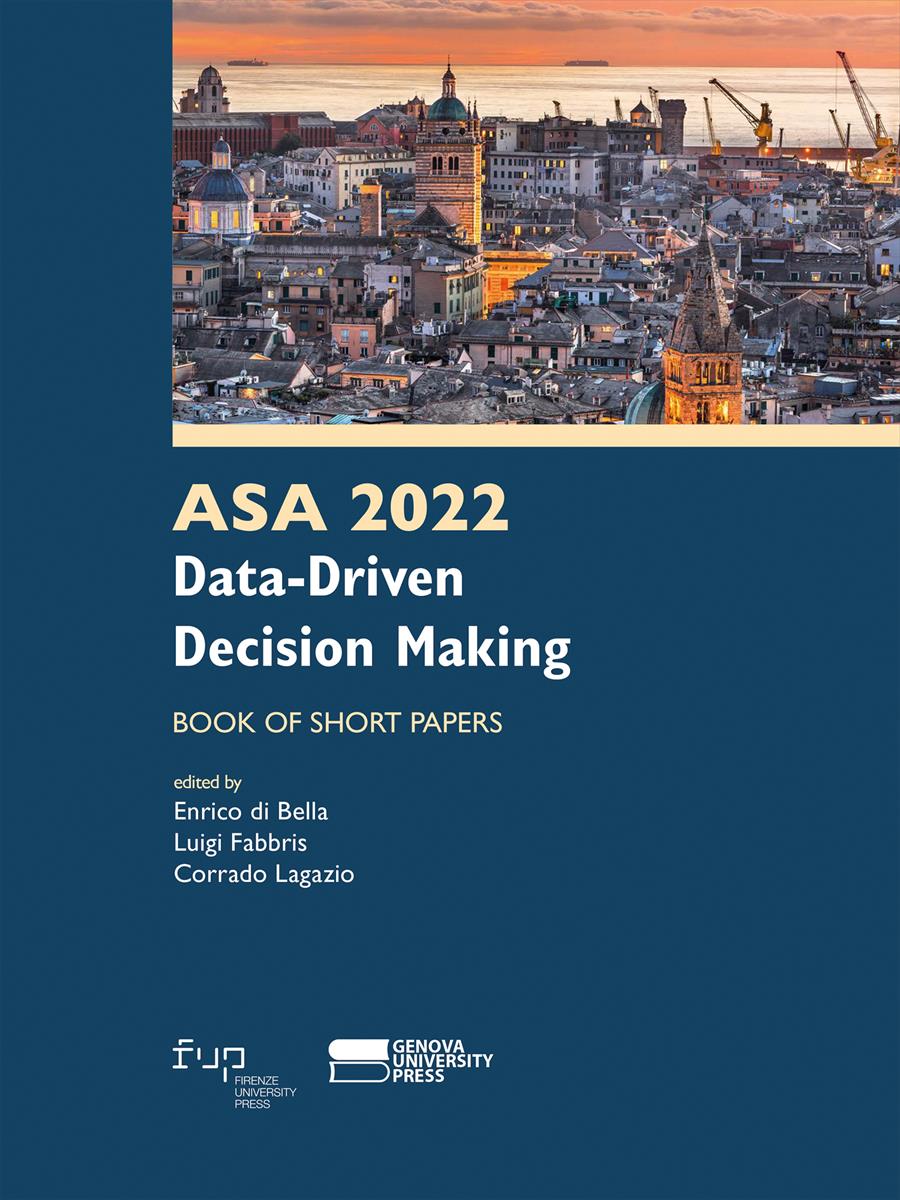- ASA 2022 Data-Driven Decision Making
- Edited by Enrico di Bella, Luigi Fabbris, Corrado Lagazio
Spread of Covid-19 epidemic in Italy between March 2020 and February 2021: empirical evidence at provincial level
- Fabrizio Antolini
- Samuele Cesarini
- Francesco Giovanni Truglia
- © 2023 Author(s) |
- CC BY 4.0
- DOI: 10.36253/979-12-215-0106-3.19
Italy was one of the countries severely affected by the Covid-19 pandemic. An analysis of the factors that played a role in the spread of this epidemic is necessary. However, the assessment of which factors may be specific, and which may contribute the most is complex and involves a high degree of uncertainty. The main objective of this study is to evaluate and analyse the statistical associations of the spread of Covid-19 infection with identified spatial context variables (density, old-age index, average temperature, and pollution). For this purpose, the developments from the spatial convergence theory were considered, as well as data from the Italian provinces from March 2020 to February 2021, referring to the first, second and third wave. The hypothesis tested in this study is to investigate the contribution of environmental and demographic factors to the convergence of observed infection rates. Based on panel data of 107 Italian provinces from the first to the third wave, this article uses a spatial autoregressive model (SAR) to analyse the conditional β-convergence of Covid-19 infection rates. The empirical results of this paper show that there is spatial conditional β-convergence in the intensity of infection rates. This means that the contagion in neighbouring areas will affect the contagion in the local area. The age structure and population density of the provinces had a certain promoting effect on the transmission of the infection, depending on the wave analysed. Regarding the observed average temperature, the effects are not very significant and inconsistent. For the first and last wave, the level of pollution is significant in explaining the convergence processes of the infection. We demonstrate that accounting for spatial factors is essential to capture key features of the spread of Covid-19 infection.
- Keywords:
- Covid-19,
- Italian provinces,
- Conditional β-convergence,
- SAR model,
University of Teramo, Italy - ORCID: 0000-0002-3112-524X
University of Teramo, Italy - ORCID: 0000-0001-7062-1580
ISTAT, Italian National Institute of Statistics, Italy
- Alexiadis, S. (2010) Regional Convergence-clubs and Dynamic Externalities. Italian Journal of regional Science, 9(1).
- Akaike, Hirotugu (1974). A new look at the statistical model identification. In IEEE Transactions on Automatic Control 19(6), pp. 716–723.
- Arbia, G. (2005). Convergence in Per-capita GDP across European Regions using Panel Data Models Extended to Spatial Autocorrelation Effects. ISAE Working Paper, No.51. SSRN: http://ssrn.com/abstract=936327.
- Azuma, K., Yanagi, U., Kagi, N., Kim, H., Masayuki, M., & Hayashi, M. (2020). Environmental factors involved in SARS-CoV-2 transmission: effect and role of indoor environmental quality in the strategy for COVID-19 infection control. Environmental Health a
- Barro, R. J., Sala-I-Martin, X. (1992). Convergence. Journal of Political Economy, 100, pp. 223-251.
- Baumol, W. J. (1986). Productivity Growth, Convergence and Welfare: What the Long-Run Data Show. American Economic Review, 76, pp. 1072-1085.
- Copat, C., Cristaldi, A., Fiore, M., Grasso, A., Zuccarello, P., Signorelli, S. S., Conti, G., & Ferrante, M. (2020). The role of air pollution (PM and NO2) in COVID-19 spread and lethality: A systematic review. Environmental Research, 191.
- Cutrini E., Salvati L. (2021). Unraveling spatial patterns of COVID-19 in Italy: Global forces and local economic drivers. Regional Science Policy and Practice, 13(S1), pp. 73-108.
- Goumenou, M., Sarigiannis, D., Tsatsakis, A., Anesti, O., Docea, A. O., Petrakis, D., and Calina, D. (2020). COVID 19 in Northern Italy: An integrative overview of factors possibly influencing the sharp increase of the outbreak (Review). Molecular Medicin
- Guliyev, H. (2020). Determining the Spatial Effects of COVID-19 Using the Spatial Panel Data Model. Spatial Statistics, 38.
- Guo, G., Wu, Z., and Chen, Y. (2020). Evaluation of spatially heterogeneous driving forces of the urban heat environment based on a regression tree model. Sustainable Cities and Society, 54.
- LeSage, J.P. (1998). Spatial Econometrics. Department of Economics. University of Toledo.
- Liu, X., Sun, T., and Feng, Q. (2020). Dynamic spatial spillover effect of urbanization on environmental pollution in China considering the inertia characteristics of environmental pollution. Sustainable Cities and Society, 53.
- Mankiw, N.G. (1992). A Contribution to the Empirics of Economic Growth. The Quarterly Journal of Economics, 107(2), pp. 407–437.
- Moosa, I. A., Khatatbeh, I. N. (2021). Robust and fragile determinants of the infection and case fatality rates of Covid-19: international cross-sectional evidence. Applied Economics, 53(11), pp. 1225-1234.
- Solow, R. M., T. W. Swan (1956) Economic Growth and Capital Accumulation. Economic Record, 32, pp. 334-361.
- Truglia, F.G. (2021). La nuda città. Spillover territoriali dei contagi da Covid-19 a Roma nella “seconda ondata”, in La metropoli continua Storia e vita sociale del quadrante Sud di Roma, Materiali e Documenti n.78 ed., La Sapienza University Press, pp.
- Zhao, R., Zhan, L., Yao, M., and Yang, L. (2020). A geographically weighted regression model augmented by Geodetector analysis and principal component analysis for the spatial distribution of PM2. 5. Sustainable Cities and Society, 56.
Chapter Information
Chapter Title
Spread of Covid-19 epidemic in Italy between March 2020 and February 2021: empirical evidence at provincial level
Authors
Fabrizio Antolini, Samuele Cesarini, Francesco Giovanni Truglia
Language
English
DOI
10.36253/979-12-215-0106-3.19
Peer Reviewed
Publication Year
2023
Copyright Information
© 2023 Author(s)
Content License
Metadata License
Bibliographic Information
Book Title
ASA 2022 Data-Driven Decision Making
Book Subtitle
Book of short papers
Editors
Enrico di Bella, Luigi Fabbris, Corrado Lagazio
Peer Reviewed
Publication Year
2023
Copyright Information
© 2023 Author(s)
Content License
Metadata License
Publisher Name
Firenze University Press, Genova University Press
DOI
10.36253/979-12-215-0106-3
eISBN (pdf)
979-12-215-0106-3
eISBN (xml)
979-12-215-0107-0
Series Title
Proceedings e report
Series ISSN
2704-601X
Series E-ISSN
2704-5846
